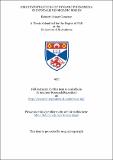NMR investigations of dynamic phenomena in crystalline organic solids
Abstract
The study of the following compounds is based on the premise that high symmetry in molecules should lead to low barriers to molecular motion even in the solid state i.e. the principle of least distress. The study of 3,3-diethylpentane is a very nice example of a phase change which results in no chemical shift changes but, produces a sharp discontinuity in the rate of ethyl group rotation. A large discontinuity in rate of molecular motion is also observed in 4,4-dipropylheptane which is also due to a phase change. The following study of tetraalkyl ammonium halides revealed both alkyl group rotation and cation tumbling to be occurring. This is most significant in the tetramethyl ammonium halides where the effects of methyl rotation and cation tumbling are shown to overlap considerably. The activation energies for the cation tumbling in the tetramethyl ammonium halides are Ea= 30 - 36 kJ mol⁻¹ and for ethyl group rotation in tetraethyl ammonium chloride are, △H†; = 57.8 kJ mol⁻¹ and △S†; = 45.9 J K⁻¹ mol⁻¹. The chemical shift differences in each chain due to different chain lengths is seen in tetrabutyl ammonium iodate which also shows a sudden coalescence and introduction of rapid molecular motion after two small phase changes. This compound has a large phase change which also affects the rate of molecular motion. The tetraalkyl phosphonium halides have a greater degree of molecular motion than the ammoniums in the temperature range studied and also offer the chance to use Tip measurements. The tetramethyl phosphonium halides show a distinct cation tumbling as opposed to the ammoniums. The process in the chloride and bromide which have hexagonal structures gives △H†; ~ 30 kJ mol⁻¹ and negative △S†; values and the lower symmetry iodide has △H†; = 45.2 kJ mol⁻¹ and a positive value of △S†;. The tetraethyl phosphonium halides show ethyl group rotations measurable to varying degrees by 13CT1p. The tetrabutyl phosphonium halides also have the different chain lengths as seen for the ammonium compounds. They also show bond rotations which are quite difficult to measure by 13CT1p values. The study of bis-(hydroxymethyl)cyclopentane (BHMCP) in an attempt to study ring puckering/pseudorotation in cyclopentane derivatives in the solid state reveals a hydrogen bond exchange process (△Gc†;~ 60 kJ mol⁻¹). The bicyclic derivatives of BHMCP showed no such molecular motions but did reveal some interesting solid- solid phase transitions and chemical shift changes. The study of trans-cyclopentanediol yields △H†; = 77.0 and △S&†; = 184 J K⁻¹ mol⁻¹ for the processes involved. The study of 4,4-dimethyl-trans⁻¹,2-cyclopentanediol reveals two processes. One results in the coalescence of resonances and appears to be a hydrogen bonding exchange process. The other is a much lower energy process (Ea ~ 26 kJ mol⁻¹) which could be a ring puckering process. The study of sulpholane also shows significant molecular motion with △H&†; = 50.6 kJ mol⁻¹ and △S&†; = 77.9 J K⁻¹ mol⁻¹.
Type
Thesis, PhD Doctor of Philosophy
Collections
Items in the St Andrews Research Repository are protected by copyright, with all rights reserved, unless otherwise indicated.

